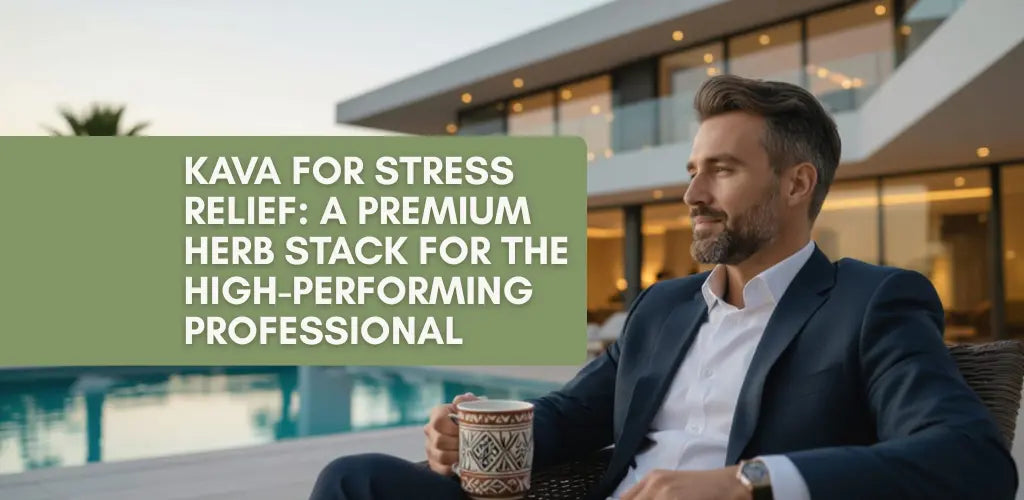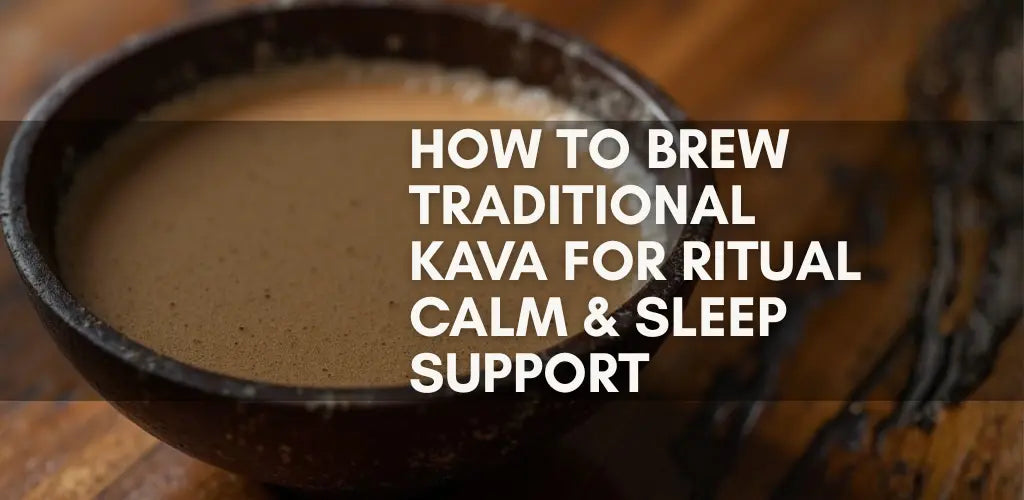Kava for Stress Relief
For executives, creatives, and high-performers who burn the candle at both ends, stress isn't just an inconvenience. It's a strategic liability that compounds daily until your decision-making dulls, your sleep fragments, and your edge disappears. We've spent years studying how elite professionals can use kava root as a precision tool for stress resilience rather than just another supplement in the cabinet. This is about building sustainable high performance through intelligent botanical intervention.
Key Facts: Kava for Professional Stress Management
- Clinical efficacy: 26% remission rate for generalized anxiety disorder vs 6% placebo in double-blind trials1
- Cognitive preservation: Reduces anxiety without impairing reaction time or processing speed2
- Mechanism: Modulates GABA activity and reduces cortisol without benzodiazepine receptor binding3
- Optimal timing: Effects onset in 20-30 minutes, peak at 1.8 hours, duration 4-6 hours
- Strategic stacking: Pairs effectively with ashwagandha (morning) and skullcap (daytime support)
- Safety profile: Non-addictive, no withdrawal symptoms, no next-day impairment when using noble cultivars4
The approach differs entirely from conventional stress management. While most professionals reach for pharmaceuticals that numb rather than restore, kava for stress relief works through a fundamentally different mechanism. Instead of sedation, you get measured calmness. Instead of cognitive fog, you maintain clarity. This distinction matters profoundly when your livelihood depends on sharp judgment under pressure.
Why Stress Hits Premium Professionals Differently

High-achieving professionals experience stress through a lens that differs markedly from the general population. The demands aren't intermittent. They're relentless and multidimensional, requiring constant executive function at peak capacity. Most stress research focuses on acute episodes, but your reality involves chronic activation of the hypothalamic-pituitary-adrenal axis with little recovery time between challenges.
This matters because your body's stress response system wasn't designed for continuous operation. The HPA axis regulates cortisol through a negative feedback loop that should activate during threats, then shut down once the threat passes.5 In chronic stress conditions typical of high-performance careers, this system loses its ability to return to baseline. Studies consistently demonstrate that individuals experiencing frequent stress develop resistance to the signals that tell the body to deactivate the stress response, leading to persistent elevation of stress hormones.6
The consequences manifest in ways that directly impair professional performance. Elevated cortisol suppresses immune function, fragments sleep architecture, and gradually degrades cognitive processing speed. Memory consolidation suffers. Decision fatigue sets in earlier. Your capacity for creative problem-solving diminishes precisely when you need it most.
Premium professionals also face a specific vulnerability: the intersection of high cognitive load and social performance demands. You're not just managing complex information. You're doing it while maintaining composure in high-stakes interactions, making rapid decisions with incomplete data, and managing the emotional labor of leadership. This combination creates a distinctive stress signature that requires targeted intervention rather than generic relaxation techniques.

Premium Kava Kava Root
Noble cultivar kava root sourced from traditional Pacific growers. Third-party tested for kavalactone content and purity. The foundation of any serious stress management protocol.
Add to ProtocolHow Kava's Mechanism Supports Stress Response & Recovery
Kava's anxiolytic properties operate through multiple pathways that distinguish it from both pharmaceuticals and other botanicals. The primary active compounds, kavalactones, modulate GABA activity without directly binding to benzodiazepine receptors. This produces anxiolytic effects while preserving cognitive function, a critical distinction for professionals who need mental clarity alongside stress reduction.

Research demonstrates that kava affects the limbic system through mechanisms that include sodium channel modulation, enhanced GABA-A receptor binding, and monoamine oxidase B inhibition.2 A double-blind, randomized, placebo-controlled study published in the Journal of Clinical Psychopharmacology found that participants with moderate to severe generalized anxiety disorder experienced significantly greater symptom reduction with kava compared to placebo, with an effect size of 0.82. Among participants completing the controlled phase, 26% of the kava group achieved remission compared to only 6% in the placebo group.1
The neurobiological effects extend beyond immediate anxiolysis. Kava influences the HPA axis by reducing cortisol elevation during stress exposure without suppressing the axis entirely. Studies using zebrafish models demonstrated that acute kava exposure elevated brain monoamines while lowering whole-body cortisol levels.3 This suggests kava helps recalibrate stress response rather than simply dampening it, a distinction with profound implications for maintaining performance under pressure.
The pharmacodynamics matter for practical application. Kavalactones reach peak plasma concentration approximately 1.8 hours after oral administration, with effects persisting for 4-6 hours. This timeframe allows strategic dosing aligned with your stress peaks. Unlike benzodiazepines, kava doesn't produce next-day cognitive impairment or withdrawal symptoms, making it suitable for regular use in demanding professional contexts.
Perhaps most importantly for high performers, kava preserves reaction time and cognitive processing speed even at anxiolytic doses. Multiple studies confirm that kava reduces anxiety without the psychomotor impairment characteristic of pharmaceutical anxiolytics.4 This means you can deploy kava during work hours without compromising the sharp decision-making your position requires.
Essential Reading: Before implementing kava in your protocol, review our comprehensive guide on kava safety, regulation, and premium sourcing to understand quality markers and avoid inferior products that could compromise results or safety.
Designing a Nightly "Reset Ritual" with Kava Root
High-performing professionals need structured decompression protocols, not vague suggestions to "relax more." We've developed a systematic approach to evening reset rituals that uses kava as the cornerstone of physiological and psychological transition from work mode to recovery mode.
The Protocol Structure
Phase 1: Environmental Transition (6:00-7:00 PM)
Begin by creating clear boundaries between work and evening. This isn't about positive thinking. It's about leveraging circadian biology. Dim artificial lighting to signal your SCN (suprachiasmatic nucleus) that the active phase is ending. Remove work devices from your immediate environment to eliminate ambient stress cues that perpetuate cortisol elevation.
Phase 2: Kava Preparation & Consumption (7:00-7:30 PM)
Traditional kava preparation involves kneading ground root in lukewarm water for 5-10 minutes, which extracts kavalactones more effectively than simple steeping. Use a ratio of 2-4 tablespoons of medium-grind kava root per cup of water, depending on your tolerance and stress load. The act of preparation itself becomes a mindfulness anchor, signaling your nervous system that the transition is underway.
Consume kava on an empty stomach or at least 3 hours after your last meal for optimal absorption. The onset takes 20-30 minutes, during which you can engage in light stretching or breathing exercises to amplify the parasympathetic shift.
Phase 3: Cognitive Download (7:30-8:00 PM)
As kava begins taking effect, perform a structured brain dump. Write out tomorrow's priorities, unresolved concerns, and any mental loops that could fragment your sleep. This externalization process, combined with kava's anxiolytic effects, prevents rumination that typically disrupts sleep onset in high-stress professionals.
Phase 4: Recovery Activities (8:00-9:30 PM)
With kava's effects fully present, engage in activities that promote genuine recovery rather than digital distraction. This might include light reading, conversation with family, or mobility work. The key is avoiding screens and stimulating content that reactivates your sympathetic nervous system.
Why Each Step Matters
The sequential structure isn't arbitrary. Each phase targets specific components of stress physiology. Environmental transition addresses light-regulated cortisol patterns. Kava preparation engages parasympathetic activation through ritual and anticipation. Cognitive download prevents stress-induced insomnia by addressing the planning circuits that typically fire during sleep attempts. Recovery activities consolidate the physiological shift toward restoration.
This approach recognizes that high-performance stress isn't resolved through isolated interventions. You need systems that address the full spectrum of stress physiology, with kava serving as the pharmacological anchor that makes the behavioral components more effective.
Herb Stack Options Alongside Kava
Strategic herb stacking allows you to target multiple dimensions of stress physiology simultaneously. However, combining herbs requires understanding pharmacokinetic interactions and avoiding excessive sedation that impairs function. We've refined combinations specifically for maintaining high performance while building stress resilience.
Kava + American Skullcap
Synergy Profile: Complementary nervous system support
American Skullcap (Scutellaria lateriflora) functions as both a nervine relaxant and a trophorestorative, meaning it provides immediate calming while nourishing nervous system tissue over time. Unlike kava's rapid anxiolysis, skullcap offers gentler, more sustained nervous system modulation. The combination works particularly well for professionals experiencing both acute stress and underlying nervous exhaustion.
The practical application involves using kava for evening reset rituals while incorporating skullcap earlier in the day during high-stress periods. A mid-afternoon dose of skullcap (1-2 ml of tincture or 300-500 mg of dried herb in tea) can prevent stress accumulation without producing drowsiness, while kava handles the evening decompression.

Premium Skullcap Herb
American Skullcap (Scutellaria lateriflora) for daytime nervous system support. Gentle nervine that prevents stress accumulation without drowsiness. Perfect complement to evening kava protocols.
Add to StackKava + Ashwagandha
Synergy Profile: Acute relief plus long-term adaptation
Ashwagandha operates through different mechanisms than kava, primarily modulating cortisol levels and supporting adrenal function over weeks rather than hours. Research demonstrates that ashwagandha reduces serum cortisol by approximately 28% after 8 weeks of consistent use. When combined with kava's immediate anxiolytic effects, you get both rapid symptom management and gradual stress resilience building.
However, timing matters critically. Take ashwagandha in the morning (300-600 mg) to support your stress response throughout the day, reserving kava for evening use. This prevents excessive sedation while allowing each herb to work optimally within its timeframe.

Premium Ashwagandha Root
Withania somnifera root for morning stress resilience. Reduces cortisol by 28% over 8 weeks while supporting adrenal function. The adaptogenic foundation of any serious professional protocol.
Add to StackImportant safety note: Both herbs undergo hepatic metabolism, so individuals with liver concerns should consult healthcare providers before combining them. For most healthy professionals, moderate doses present minimal risk, but monitoring is prudent during extended use.
Combinations to Avoid
Do not combine kava with pharmaceutical sedatives, including benzodiazepines or sleep medications. The synergistic effects can produce dangerous levels of CNS depression. Similarly, avoid combining kava with valerian root, as both significantly enhance GABAergic activity, potentially causing excessive drowsiness, cognitive impairment, and next-day residual effects that compromise professional performance.
Alcohol and kava should never be combined. Both are hepatically metabolized and produce similar effects on the central nervous system. The combination substantially increases the risk of liver toxicity and can cause severe cognitive impairment.
Advanced Learning: For professionals seeking mastery-level understanding of kava sourcing and cultivar differences, see our detailed analysis of premium kava cultivars and what high-end buyers should know.
Monitoring Results: Biomarkers, Feel-State, Sleep Quality
Elite professionals measure what matters. Implementing kava without tracking results means operating blind. We've developed a tiered monitoring system that balances precision with practicality.
Subjective Metrics (Daily Tracking)
Start with simple daily logs tracking three variables: stress intensity (1-10 scale), sleep onset latency (minutes from lights out to sleep), and morning cognitive clarity (1-10 scale). Record these consistently for at least two weeks before introducing kava to establish baseline, then continue throughout implementation. This provides immediate feedback on whether your protocol is working.
Professional tip: Use a spreadsheet or app with trend visualization. Numeric tracking without visualization makes it difficult to detect gradual improvements that compound over weeks.
Sleep Architecture (Wearable Data)
Consumer wearables like Oura Ring or Whoop provide reasonable proxies for sleep quality through metrics like resting heart rate, heart rate variability, and sleep stage distribution. While not clinical-grade, they're sufficient for detecting meaningful changes in recovery quality.
What to watch: HRV typically increases as stress management improves. Resting heart rate should gradually decrease. Deep sleep percentage should stabilize or increase. If you see consistent improvements across these metrics over 4-6 weeks, your protocol is working at the physiological level.
Cognitive Performance (Objective Testing)
Use validated cognitive assessment tools like Cambridge Brain Sciences or Stroop tests to track working memory, processing speed, and executive function. Test monthly rather than daily to avoid practice effects. Improvements in these metrics indicate that stress reduction is translating to functional cognitive gains.
Biomarker Testing (Quarterly Assessment)
For comprehensive validation, consider quarterly testing of key stress biomarkers. A basic panel includes morning cortisol, DHEA-S (to assess adrenal reserve), and high-sensitivity CRP (systemic inflammation marker). More advanced testing can include a four-point salivary cortisol curve to assess diurnal rhythm.
Target ranges for optimization: Morning cortisol should fall between 10-20 mcg/dL (not just "within normal range" but optimized for performance). HPA axis dysfunction often shows as either chronically elevated morning cortisol or flattened diurnal curves where evening cortisol remains inappropriately high.
When to Adjust
If subjective metrics improve but sleep data doesn't change within 3 weeks, consider adjusting kava timing or dose. If cognitive testing shows no improvement after 6 weeks, the protocol may need expansion beyond kava alone. If biomarkers don't shift after 3 months, consultation with a functional medicine practitioner is warranted to address upstream issues.
Safety & Medical Considerations
Consult qualified healthcare providers before using kava if you: Have a history of liver disease or dysfunction, are pregnant or nursing, take prescription medications (particularly CNS depressants or medications metabolized by CYP450 enzymes), have upcoming surgery scheduled (discontinue kava at least 2 weeks prior), or have a history of substance abuse. While kava has a strong safety profile when used appropriately, individual responses vary.
Standard precautions: Use only water-extracted kava from noble cultivars. Avoid kava derived from aerial parts or stem peelings, which contain hepatotoxic compounds. Do not exceed recommended dosing (typically 120-250 mg kavalactones per day). Take periodic breaks (1 week off every 6-8 weeks of continuous use). Monitor for rare adverse effects including skin changes, visual disturbances, or signs of liver stress (jaundice, dark urine, unusual fatigue).
Implementation Protocol for High Performers
Theory matters little without execution. Here's your systematic implementation plan.
Week 1-2: Baseline & Sourcing
Establish baseline metrics using the tracking systems described above. Source premium kava root from reputable suppliers who provide third-party testing for kavalactone content and contaminants. Don't compromise on quality. Poor-quality kava produces inconsistent results and increases safety concerns.
Week 3-4: Protocol Introduction
Begin with conservative dosing (1-2 tablespoons of medium-grind root, approximately 60-120 mg kavalactones). Use only in the evening as part of your reset ritual. Document effects in your tracking system. Some individuals experience reverse tolerance, where effects strengthen over several days of consistent use.
Week 5-8: Optimization
Adjust dosing based on response. If effects are minimal, increase gradually to 3-4 tablespoons (120-180 mg kavalactones). If you experience excessive sedation or next-day grogginess, reduce dose or timing. Consider adding complementary herbs (ashwagandha in morning, skullcap if needed for daytime support).
Month 3+: Maintenance & Refinement
Review your tracking data monthly. Schedule quarterly biomarker testing. Adjust protocol based on objective and subjective metrics. Take scheduled breaks to assess whether kava remains necessary or if your stress resilience has improved sufficiently to reduce frequency.
The goal isn't perpetual supplementation. It's building sufficient stress resilience that you can maintain high performance with minimal intervention. Kava serves as the bridge to get you there.
The Strategic Advantage
High-performing professionals operate in an arms race of cognitive capacity and stress management. The individuals who maintain peak performance over decades rather than burning out in years have mastered the art of strategic recovery. Kava for high performance wellness isn't about escaping stress. It's about building the physiological infrastructure to thrive under pressure sustainably.
This approach requires rejecting both the pharmaceutical path (which trades performance for symptom suppression) and the purely behavioral path (which ignores biochemical realities). Instead, you leverage targeted botanical intervention to recalibrate stress physiology while implementing the behavioral systems that make that intervention effective.
The result: sustained high performance without the typical degradation pattern. Better decision-making under pressure. Faster recovery between challenges. Preservation of cognitive function well into career maturity. These aren't small advantages. They're the difference between a 10-year high-performance career and a 30-year one.
Your move.
References
- Sarris J, Stough C, Bousman CA, et al. Kava in the treatment of generalized anxiety disorder: a double-blind, randomized, placebo-controlled study. Journal of Clinical Psychopharmacology. 2013;33(5):643-648. https://pubmed.ncbi.nlm.nih.gov/23635869/
- Sarris J, LaPorte E, Schweitzer I. Kava: a comprehensive review of efficacy, safety, and psychopharmacology. Australian & New Zealand Journal of Psychiatry. 2011;45(1):27-35. https://pubmed.ncbi.nlm.nih.gov/21073405/
- Bhat A, Pires AS, Tan V, Babu H, Sukumaran S, Chaudhari A, Pannia E, Kubant R, Coppola V, Anderson GH, Kalueff AV. Effects of acute and chronic kava extract treatment on anxiety, depression and social behavior, and brain monoamines, cortisol and GABA in the zebrafish. Pharmacology Biochemistry and Behavior. 2018. https://www.sciencedirect.com/science/article/abs/pii/S1744388118301981
- Antos Z, Zackiewicz K, Tomaszek N, Modzelewski S, Waszkiewicz N. Beyond Pharmacology: A Narrative Review of Alternative Therapies for Anxiety Disorders. Diseases. 2024;12(9):216. https://pubmed.ncbi.nlm.nih.gov/39329885/
- Cleveland Clinic. HPA Axis: The Stress Response System. Updated August 2025. https://my.clevelandclinic.org/health/body/hypothalamic-pituitary-adrenal-hpa-axis
- Herman JP, McKlveen JM, Ghosal S, et al. Regulation of the hypothalamic-pituitary-adrenocortical stress response. Comprehensive Physiology. 2016;6(2):603-621. https://pmc.ncbi.nlm.nih.gov/articles/PMC4867107/
Additional resources consulted: PubMed Central systematic reviews on kava efficacy and safety, Springer journals on HPA axis dysfunction, University of New Hampshire Psychological & Counseling Services resources on stress physiology, and peer-reviewed research on adaptogenic herb combinations.





